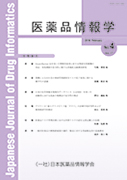Volume 17, Issue 4
February
Displaying 1-6 of 6 articles from this issue
- |<
- <
- 1
- >
- >|
Original artcle
-
2016 Volume 17 Issue 4 Pages 175-184
Published: 2016
Released on J-STAGE: March 19, 2016
Download PDF (611K) -
2016 Volume 17 Issue 4 Pages 185-191
Published: 2016
Released on J-STAGE: March 19, 2016
Download PDF (423K) -
2016 Volume 17 Issue 4 Pages 192-198
Published: 2016
Released on J-STAGE: March 19, 2016
Download PDF (443K)
Short communication
-
2016 Volume 17 Issue 4 Pages 199-204
Published: 2016
Released on J-STAGE: March 19, 2016
Download PDF (464K) -
2016 Volume 17 Issue 4 Pages 205-208
Published: 2016
Released on J-STAGE: March 19, 2016
Download PDF (720K)
Note
-
2016 Volume 17 Issue 4 Pages 209-216
Published: February 29, 2016
Released on J-STAGE: March 19, 2016
Download PDF (663K)
- |<
- <
- 1
- >
- >|
